This report will review some of the history and ideology of the Turkish organization Ülkü Ocakları ("Idealist Hearths") also known as the Bozkurtlar ("Grey Wolves") before examining the actions of its leadership and members as recorded in open sources. These activities include: fighting in Syria and Azerbaijan outside of conventional Turkish military forces; praising those killed from official organization outlets; shipments of supplies to armed groups in Syria; and praise from official outlets for Shamil Basayev, a chechen terrorist leader who directed dozens of attacks in Russia that killed hundreds of civilians. The Ülkü Ocakları is an arm of the Milliyetçi Halk Partisi (MHP), which is the smaller of two parties in a coalition governing the country, the other being President Recep Tayyip Erdoğan's AKP.
German National Socialism, Turkish Turanism And The Background Of The Ülkü Ocakları
With the rise of fascism in Europe in the 1920s and 1930s, existing racial political trends in Turkey gained influence. Some who were propagating Turanism[1] in Turkey found familiar ideas in the blood-and-soil thinking of National Socialism. Alparslan Türkeş, who later founded and lead the Ülkü Ocakları, played an integral role in a growing Turkish racialist political movement during this period. He propagated Turanist ideology and was an avowed sympathizer and supporter of Hitler.[2] Hitler's government also sought ideological allies against the USSR and the Western Powers, and in June 1941 the Turkish and German governments signed a non-aggression pact.
Whether there was any back-channel diplomatic connection between Hitler's government and the Turanists is a subject of debate. Social scientist Kemal Bozay and others have referred to an SS brigade leader who reported in 1944 to the Foreign Affairs Ministry of the Third Reich that a connection had been established with the leader of the pan-Turkish movement, likely referring to Türkeş.[3] MHP MP Ümit Özdağ has said that such claims are made only in unreliable and politically motivated books. In a column on this issue, Özdağ noted a book by writer Ecevit Kılıç, who discusses the connection between Türkeş and Hitler's government, citing Swiss author Daniele Ganser. Özdağ says that Ganser cites secondary and tertiary sources, including "propaganda books that the PKK had printed in Germany."[4] It is expected that an MP for the MHP, of which the Ülkü Ocakları is a branch, would want to downplay any connection between Türkeş and Hitler. Whether or not Türkeş had contact with Hitler's government, Türkeş was a major figure in the movement in Turkey at that time, and in September 1944 he was tried and sentenced along with 22 other nationalists. He was sentenced to nine months and 10 days in prison for spreading "propaganda."[5] In March 1945 he and 12 others in the case were acquitted of their charges. He said during the trial: "I am a Turkish nationalist, but I am not, as has been claimed, a racist."[6]
In 1966, Türkeş formally established an organization called the Ülkü Ocakları Birliği ("Union of Idealist Hearths"). In 1973, following a putsch in the country in 1971, the group continued under the name Ülkü Ocakları Derneği ("Association of Idealist Hearths"). Ahead of the 1980 putsch in Turkey, this organization was involved in street violence between leftists and rightists. It generally operated as the youth arm of the MHP and Türkeş, who founded and led the MHP, took a special interest in the development of the group, which came to be known as the Ülkü Ocakları, until his death in 1997.[7]
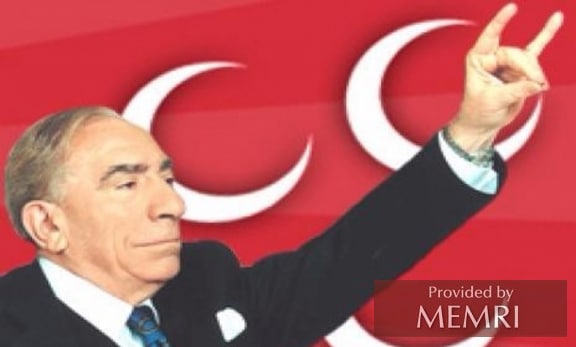
Ülkü Ocakları founder Alparslan Türkeş giving the Ülkü Ocakları salute.
Today the organization's full name is the Ülkü Ocakları Eğitim Ve Kültür Vakfı ("Idealist Hearths Educational and Cultural Foundation").[8] It is generally known simply as the Ülkü Ocakları or Bozkurtlar ("Grey Wolves"), and its members and supporters as ülkücüler ("idealists"). In this report it will be referred to as the Ülkü Ocakları.
Ülkü Ocakları Ideology – Islamism And Ethno-Nationalism
Ülkü Ocakları ideology is organized around ethnic nationalism, Islamism, and Turanism. For the most part, it combines Islamist and Turkish nationalist rhetoric to promote a vision of a uniform Turkish nation with Islam as its religion. This relatively straightforward picture is complicated by the use by many of the group's members and supporters of pre-Islamic Turkish symbology, including Turkic runes and religious terminology associated with Tengrism,[9] a Turkish shamanistic religion to which Turks adhered before the Seljuks, who are among the ancestors of modern Turks and who later migrated into what is today Turkey, converted to Islam in 985.[10]
The Ülkü Ocakları's official media mostly refrains from such messaging, but the symbol of the wolf, which the group uses extensively, is itself a pre-Islamic Turkic symbol. Also the Ülkü Ocakları do not, for example, use the early Arab caliphs extensively in their messaging, as many Turkish Islamist groups do. The group instead presents the Turkish nation as the heir of the legacy of Central Asia. Turkish Islamists will also often be deferrential toward and sometimes revere Arabs and the Arabic language generally for their central role in the history of Islam. Alternatively, Ülkü Ocakları supporters, while Muslim, generally do not do this in their messaging, and are often hostile to the Syrian migrants in Turkey, among others. This may indicate that the ideology and its adherants prioritize Turkishness over Muslimness. The group however does often make use of the "three crescents," a set of symbols long used on the Ottoman flag to denote the three continents, Europe, Asia, and Africa, that the empire spanned. The MHP, of which the Ülkü Ocakları is an arm, is also the only party that uses the three crescents in its official party flag.
This balancing of religion and nation can be seen in the symbology of the official emblem of the Ülkü Ocakları, which features a crescent, a symbol of Islam popularized by the Ottomans, a wolf, and the color blue. Both blue and the symbol of the wolf were used in the flag of the First Turkic Khaganate in the sixth to eighth centuries.
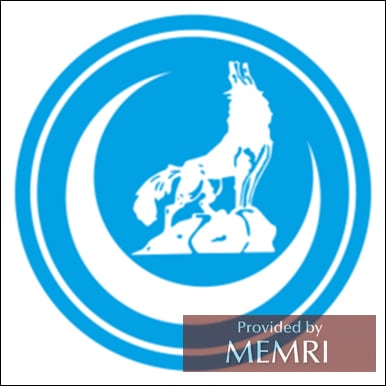
Ülkü Ocakları emblem
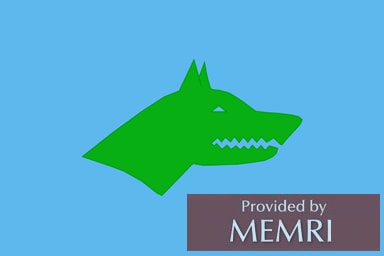
A flag reportedly used by the First Turkic Khaganate.
The racial component of the Ülkü Ocakları ideology leads the group's members to express hostilty toward, threaten, attack, and sometimes kill members of minority ethnic groups in Turkey, including Kurds,[11] Armenians,[12] opposition political leaders,[13] and even Korean tourists,[14] sometimes on behalf of Uyghur Muslims in China.[15] In particular they have fought often with members and supporters of the PKK, a Kurdish terrorist organization, and the HDP, a predominantly Kurdish political party in Turkey.[16] On October 7, 2014, amid a violent period between the PKK and the Ülkü Ocakları groups, a car reportedly driven by an Ülkü Ocakları supporter plowed into a crowd of Kurdish protesters in Istanbul.[17] This fighting sometimes extends to diaspora communities living in the West, as it did in October 2017 when Ülkü Ocakları supporters "went mad and searched for PKK supporters everywhere and chased them" in Antwerp, Belgium.[18]
The Nine Lights Doctrine, which Alparslan Türkeş formulated and articulated in 1965 as the party program of Cumhuriyetçi Köylü Millet Partisi'nin (Republican Villagers Nation Party, CKMP, which later became the MHP), and then again in 1969 as the party program of the MHP, is central to the political ideology of the Ülkücü movement, which continues to cite the doctrine in its publications.[19] The nine concepts of this doctrine are: Nationalism, Idealism, Moralism, Scientism, Socialism, Agricultural Development, Liberalism and Individualism, Development and Populism, and Industrialism and Technology.
Ülkü Ocakları Activity In The Syria War From 2013 To Today
There is significant evidence of Ülkü Ocakları activity in the Syria War. Many of the group's members have been documented fighting there. These men are not simply members of the organization, but are endorsed, supported, and praised by the Ülkü Ocakları leadership, and are sometimes themselves among its leaders. They also have extensive connections with the MHP, which is part of the two-party coalition that governs Turkey, alongside President Erdoğan's AKP.
While there have been many Turkish military operations in Syria in recent years, including several major incursions, these fighters are not part of the Turkish regular military force: their military attire resembles that of guerilla fighters rather than that of a regular army; they have no insignia or emblems on their uniforms indicating affiliation with the Turkish military; no mention of them online indicates such affiliation; and there has been no official Turkish military operation in Syria's Latakia province, where much of their activity has been documented. Some other auxiliary forces in Syria, such as the Sultan Murad Division, which Turkey's national intelligence service, the Milli İstihbarat Teşkilatı (MİT), reportedly established in 2012 and which is trained in and has its salaries paid by the Turkish government,[20] have moved in tandem with Turkish regular forces in their major operations, such as Operation Euphrates Shield.[21] However, there are no reports that the fighters from the Ülkü Ocakları have done the same. It is, however, unlikely that the Ülkü Ocakları are able to move fighters and supplies over the Turkey-Syria border without coordination with and approval from the Turkish government and military.
Much of the material in this report reflects activity in and around the Turkmen Mountain range of what is today Latakia province in Syria. The borders of Turkey were primarly determined by the 1923 Treaty of Lausanne and the 1926 Treaty of Ankara. However in 1939, following the withdrawal from Hatay of French troops, the Parliament of Hatay voted unanimously to become part of Turkey, which Turkey accepted and France recognized.[22] Today, Hatay is Turkey's southernmost province and extends south into Syria beyond the rest of the Turkey-Syria border. Turkmen Mountain is the area of Syria immediately south of Hatay's southern border, in Syria's Latakia province, and it reportedly has 27 villages of Turkmens. Syrian Turkmens are Syrian citizens of Turkish origin, many of whom trace their ancestry to geography that is today Turkey. There are an estimated 200,000 to 3.5 million Turkmens in Syria and most of them live in Damascus, Latakia, Hama, Homs, Aleppo, and Raqqa.[23] Other locations in Syria mentioned in the report are Bayırbucak, which is the district of Syria's Latakia province in which the Turkmen Mountain range is found, and Aleppo. Aleppo is about 22 miles from the Turkey-Syria border, while Turkmen Mountain is about 10 miles from the same border.
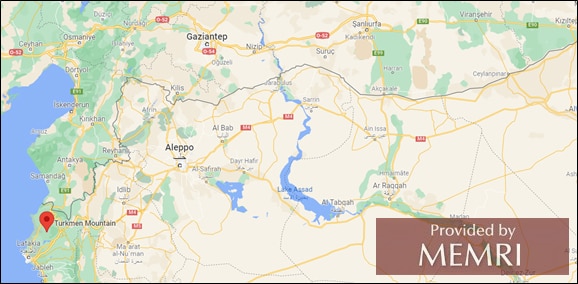
Map showing Syria's Turkmen Mountain and Aleppo near the Turkey-Syria border.
Emrah Çelik
One Emrah Çelik was photographed in Syria giving the Ülkü Ocakları salute and holding the head of a man reported to have been a Syrian soldier. Çelik appears to have a Turkish flag patch on his shoulder; it is not clear whether he was part of a regular Turkish military unit when the photo was taken. The photo surfaced online in April 2020.[24] The group's salute is extending the forefinger and pinky and touching the middle and ring finger to the thumb. The result is a shape that resembles the head of a wolf.

Emrah Çelik was an active member of the AKP's political organization for Tekirdağ province as of August 2019. The AKP is in a political coalition with the MHP, which runs the Ülkü Ocakları.

Emrah Çelik was also photographed next to a sign that reads "Turkmen Mountains – 1071 Raiders," next to which several fighters whose Ülkü Ocakları connections are clearly established, such as İbrahim Küçük and Alparslan Çelik, have also been photographed. 1071 is the year of the Battle of Manzikert, at which Sultan Alp Arslan, after whom Alparslan Türkeş is named, led a Seljuk army to victory over a Byzantine army on a field near the modern-day town of Malazgirt in Muş province, Turkey, opening the path for the Seljuk conquest of and migration into Anatolia.
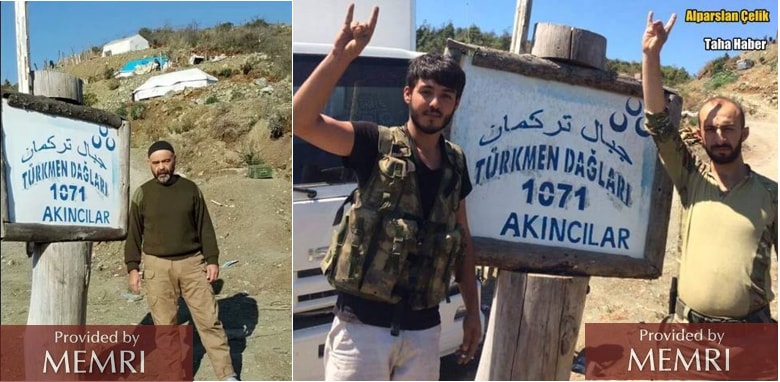
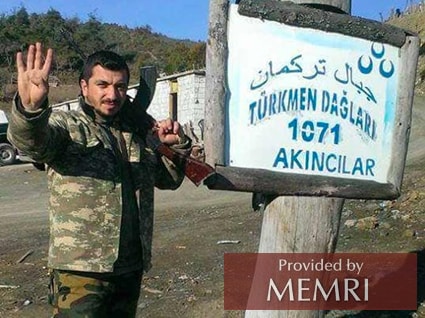
İbrahim Küçük, Alparslan Çelik, and Emrah Çelik standing next to the same sign.
Selami Aynur
Upon the March 2014 death of one Selami Aynur, the former president of the Ülkü Ocakları for Giresun, MHP officials in contact with one Adil Orli, a leader of the Turkmen militias in the Turkmen Mountain range, said: "Our boss has reached martyrdom." The building of the Ülkü Ocakları branch in Bursa Orhangazi displayed a banner commemorating Selami Aynur.[25]

Adil Orli, who was photographed in an an MHP office alongside MHP politicians and Ülkü Ocakları leaders, was featured in a 45-minute Al-Jazeera documentary on the Turkmen militia under his leadership in Syria.[26] He has said he is part of the Turkmen Mountain Martyrs Battallion of the Turkmen Mountain Division.[27] An ethnic Turkmen, Orli speaks Turkish and Arabic and was reportedly wounded by shrapnel from a Syrian government artillery strike.[28] He has referred to the fighting in Syria as jihad, saying: "We will struggle on this path until the end, with Allah's permission. It is a holy struggle, after all: jihad."[29] He gave an interview in which he described the fighting in Turkey to Pamukkale TV, a television channel based in Denizli, a city in southwest Turkey.[30]
On April 17, 2014, in the MHP's Pendik district office in Istanbul, Orli was photographed with: Fırat Söğütlü, then president of the Orhangazi branch of the Ülkü Ocakları; Hüseyin Bozan, director of the Turkmen Agency, a news outlet; and Metin Özüpek, MHP leader for the Kartal district of Istanbul. A Turkish news outlet reported that Muhammet Aytemur Haşimi and Hulusi Çolak, both leaders of the Ülkü Ocakları, and Tuna Altay aka Adem Şen, then Ülkü Ocakları leader for Pendik were also in the photo – the presence of Haşimi, Çolak, Altay, and Şen in the photo could not be independently verified.

Fatih Söğütlü, Hüseyin Bozan, Metin Özüpek appear in photo with Adil Orli (first, third, fifth, and sixth from right, respectively).
In the group photo, Orli holds a photo of Selami Aynur holding a rifle and sitting next to a child giving the Ülkü Ocakları salute.

The Ülkü Ocakları have continued to honor the memory of Selami Aynur. On March 24, 2020, the official twitter account of the Pendik branch of the Ülkü Ocakları wrote: "We remember with mercy and gratitude the sixth anniversary of the martyrdom of our former president of the Giresun Ülkü Ocakları, the martyr of Turkmen Mountain. May his soul be glad and his place be paradise."[31] The post included a graphic featuring a photo of Aynur standing on a car holding a rifle, the emblem of the Ülkü Ocakları, contact and social media information for the organization, and the name Metehan Yurtbaşı, who is the president of the Pendik branch of the Ülkü Ocakları.[32]

On March 24, 2018, Olcay Kılavuz, who is currently an MP for the MHP and was president of the entire Ülkü Ocakları organization from 2012 to 2018, wrote that Aynur had been president of the Giresun district branch of the Ülkü Ocakları, saying: "We commemorate with mercy and prayer the fourth anniversary of the martyrdom of our fellow man of the cause Selami Aynur, who had been president of the Giresun district branch of the Ülkü Ocakları. May his soul be glad and his place be paradise." The post includes a graphic featuring a photo of Kılavuz praying at Aynur's grave, as well as social media information for the Ülkü Ocakları and the group's emblem.[33] Kılavuz made a similar post on March 24, 2015, a year after Aynur's death.[34]

Kılavuz wrote a similar post on March 24, 2021.[35]

The Giresun branch of the Ülkü Ocakları commemorated Aynur's death on March 23, 2021.[36]
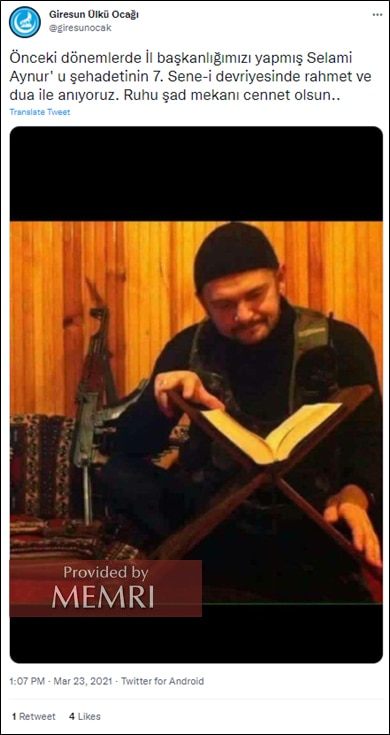
Ibrahim Bozan, who is also affiliated with the Turkmen Agency, a small Syria-based news outlet focusing on news related to the Turkmens in Syria,[37] marked the seventh anniversary of Aynur's death, and, tagging the main twitter account of the Ülkü Ocakları, wrote: "We want a cultural center in the name of Selami Aynur in the village of Havahüyük from @Ulku_Ocaklari."[38] Havahüyük is the most significant Turkmen village in Aleppo province.

On June 12, 2017, during the month of Ramadan that year, local media reported that the Ülkü Ocakları had organized an iftar meal in honor of Selami Aynur in the Turkish town of Gemlik.[39] Those attending the iftar included Orhangazi Ülkü Ocakları President Gökmen İnce, Ülkü Ocakları Gemlik İlçe Başkanı Ali Yılmaz, who also gave the opening speech for the event, MHP district leader Mehmet Emin Özcanbaz, and MHP women's division leader Hale Kapyalı.

Burak Mişinci
On July 22, 2015, an Ülkü Ocakları Facebook page reported: "Our brother Burak Mişinci fell as a martyr while fighting in Latakia alongside his Turkmen brothers. May Allah accept his martyrdom." The post links to an article on Ulkucumedya.com titled "Burak Mişinci, Who Fell As A Martyr In Syria, Was Sent Off On His Final Journey On The Shoulders Of Idealists [i.e., Ülkü Ocakları Supporters]."[40] The post is no longer available. Mişinci's funeral, reported the next day, was attended by Ülkü Ocakları Istanbul District President Ahmet Yiğit Yıldırım, among others.[41] Mişinci had reportedly been a member of the Ülkü Ocakları in Istanbul.[42]
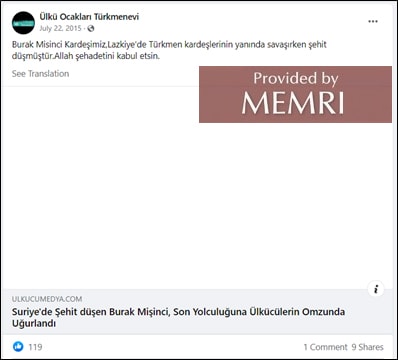
Photos of Mişinci, who was reportedly 26 years old when he died, armed in Syria have been shared widely online.[43]

On July 20, 2015, Ali Yetgin, who was Ülkü Ocaklari vice president for Istanbul province from 2005-2007 and MHP vice president for Istanbul province from 2011 to 2014, apparently broke the news of Mişinci's death by tweeting a picture of him and writing: "Our valiant Burak Mişinci of the Ülkü Ocakları was martyred fighting on Turkmen Mountain. May Allah grant our martyr mercy."[44] Later, speaking to Hurriyet daily, then Ülkü Ocakları President Olcay Kılavuz denied what Yetgin had said, saying: "He is not someone we employed. Nor is he registered in [the Ülkü Ocakları]. He may be a patriotic friend. We are saddened; may Allah grant [him] mercy."[45]
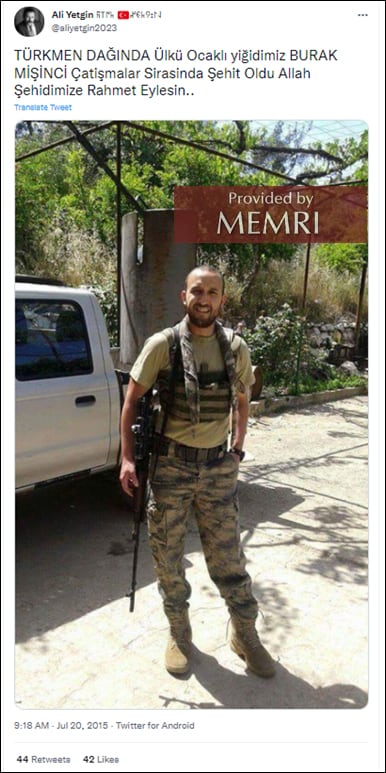
İbrahim Küçük
One Fahri Bozgeyik wrote on Facebook on January 26, 2016: "The Ülkücü Movement continues to give martyrs. İbrahim Küçük, of the MHP organization for Fatih district [of Istanbul] and the former Ülkü Ocakları president for Tekirdağ, was martyred on Turkmen Mountain in Syria. May the lord accept and be pleased with his martyrdom."[46] Bozgeyik has 281,000 twitter followers and is chairman of the board of directors of Inisyatif, an Ankara-based NGO.[47] Bozgeyik also commemorated on Twitter the death of Aynur on March 4, 2020.[48]
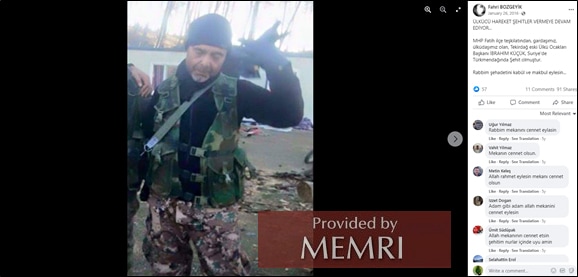
The main Ülkü Ocakları Facebook page reported Küçük's death on January 26, 2016, writing: "Former Ülkü Ocakları president for Tekirdağ Province İbrahim Küçük was martyred on Turkmen Mountain. I wish for mercy from Allah for our martyr... Olcay Kılavuz – Ülkü Ocakları General Director, January 26, 2016." An accompanying graphic bears the Ülkü Ocakları emblem, social media information, and quotes Quran 2:154: "Do not say that those who were killed in the path of Allah are dead. They are alive, but you cannot understand."
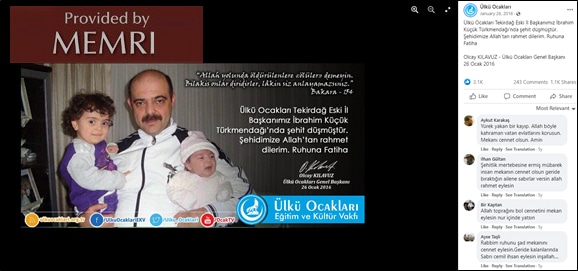
The Ülkü Ocakları continue to commemorate the anniversary of Küçük's death. The Facebook page of the Pendik branch of the Ülkü Ocakları posted on January 26, 2018, a graphic commemorating Küçük's death. The graphic features the emblem of the Ülkü Ocakları and a photo of Küçük holding a rifle.[49]
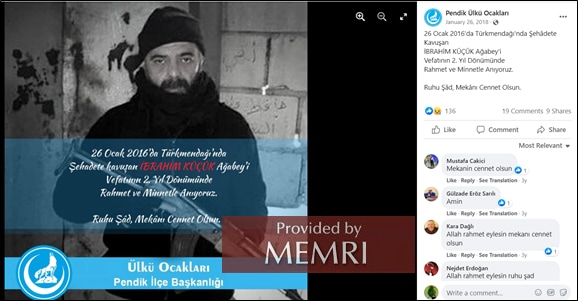
On January 26, 2020, the Facebook page for the Ülkü Ocakları branch for Avcılar district in Istanbul commemorated the anniversary of İbrahim Küçük's death with a graphic apparently produced by the organization's provincial office for Istanbul. The graphic bears the name Kazım Erdi Aktunç, who is the president of the Ülkü Ocakları for Istanbul province, and gives the URL of the main Ülkü Ocakları website, Ulkuocaklari.org.tr.[50] The photo used in the graphic is the same photo of Küçük carrying a rifle, but is edited so as not to include the rifle.

On January 26, 2021, the Esenyurt branch of the Ülkü Ocakları shared a graphic commemorating Küçük's death.[51]
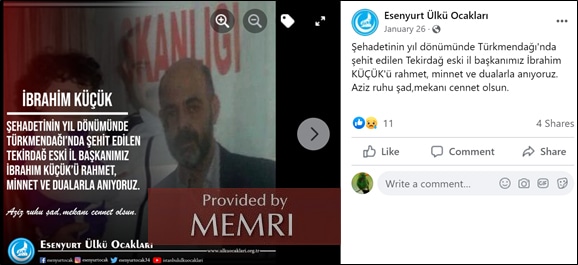
On December 10, 2020, the Bayırbucak Ülkü Ocakları Facebook page wrote: "İbrahim Küçük, the heroic Ülkücü martyr who fell as a martyr on Turkmen Mountain in Bayırbucak on January 27, 2016. We remember you with love and respect, may your soul be glad."
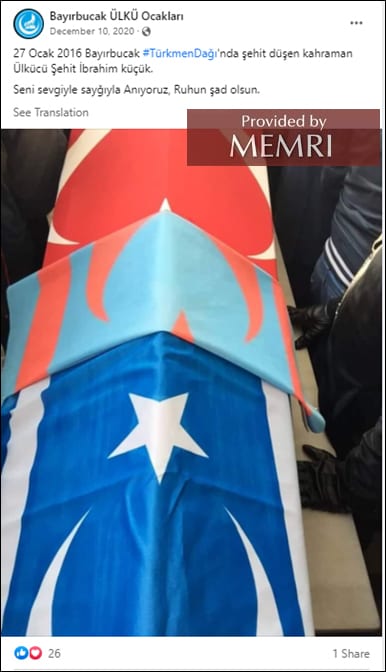
Ferhat Tüle
On February 25, 2016, the Ülkü Ocakları Facebook page for Esenyurt posted a video of a funeral and wrote: "We sent off on his final journey our brother Ferhat Tüle, who was a brave gray wolf of Esenyurt martyred in Turkmendağı."[52]

On February 24, 2021, the Bayırbucak Ülkü Ocakları Facebook page commemorated the anniversary of Tüle's death, writing: "February 25, 2016, Bayırbucak, Turkmen Mountain. We remember with mercy the idealist hero Ferhat Tüle on the anniversary of his martyrdom. May his place be paradise."

Tüle was reportedly 27 years old when he died.[53] Photos have circulated online of him carrying a rifle alongside other fighters.

Alparslan Çelik
Alparslan Çelik, from the Turkish city of Elazığ, is the son of Ramazan Çelik, an MHP politician and former mayor of Elazığ's Keban district who was in office for ten years. Ramazan reportedly said in July 2014: "For 40 years we have struggled as the Turkish nation with the flag and the Turan ideal. My son is 32 years old. If we won't die there [in Syria] with our brothers for the homeland, the flag, and brotherhood, for what will we die? My son said to me 'Dad, I'm going [to fight].' I told him 'Go. Fight until you are martyred.' If necessary, I will go too."[54]
On November 24, 2015, the Turkish military shot down a Russian fighter jet near the Turkey-Syria border. The following day, a video was uploaded to YouTube in which Alparslan Çelik, who introduced himself as the "deputy commander of the Second Turkmen Mountain Coastal Division," said that his forces had shot in the air the two Russian pilots who ejected from the jet.[55] The Facebook page of the Second Turkmen Mountain Coastal Division, of which Alparslan said he was the deputy commander, has 63,000 followers.[56]
On March 5, 2016, Turkish media reported that Alparslan had visited Yunuz Uzunlular, former president of the Ülkü Ocakları branch for Adana province.[57] On his Facebook page, Alparslan says that he is an "ülkücü."[58] Virtually everything he posts on Facebook and Twitter[59] indicates his support for the Ülkü Ocakları or the MHP, including, for example, a March 23, 2021 tweet in memory of Selami Aynur, indicating that he knew that Aynur had been killed fighting in Aleppo, specifically.[60]
A video that the Ülkü Ocakları uploaded to YouTube on November 22, 2015, shows Alparslan Çelik and two armed men giving the Ülkü Ocakları salute and standing in front of two piles of boxes marked with the emblem and name of the Ülkü Ocakları in Bayırbucak, Syria.[61] In a March 2016 interview, Alparslan said that the Ülkü Ocakları, among others, were supporting the fighters in Turkmen Mountain.[62] On April 3, 2016, Turkish media reported that he had been arrested in Turkey's İzmir province[63] and in May 2017 he was sentenced to five years in prison on firearms charges. Alparslan Çelik's social media accounts continue to be updated regularly.[64]
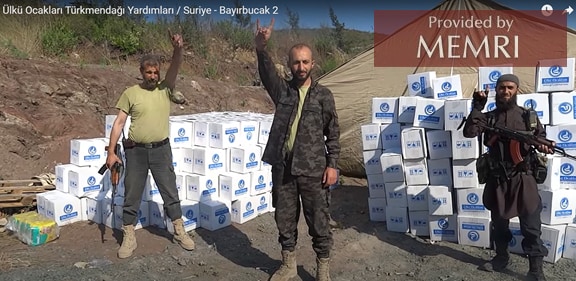
Alparslan Çelik stands in front of piles of boxes with the Ülkü Ocakları emblem in Syria.

Alparslan Çelik's Facebook page.
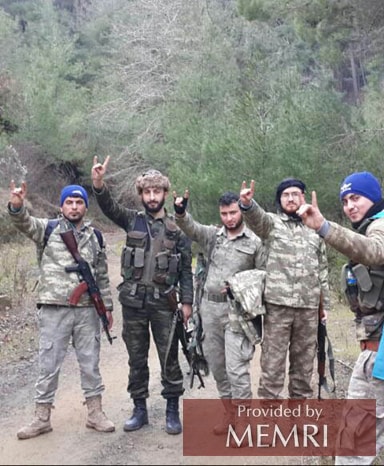
Alparslan Çelik, second from left, in Syria giving the Ülkü Ocakları salute.

Alparslan Çelik, rear, third from right, in Syria giving the Ülkü Ocakları salute.
Formal Ülkü Ocakları Organizational Structure Inside Syria
There is a Facebook account named "Bayırbucak Ülkü Ocakları." Bayırbucak is an area of the Latakia district of Latakia province in northwest Syria in which there is a high Turkmen population. It is also the location of Turkmen Mountain range. The existence of such a Facebook page is notable because it resembles the Facebook pages of the district and provincial branches of the Ülkü Ocakları inside Turkey. This Facebook page, whose first post was made on July 26, 2020, suggests the existence of not only Ülkü Ocakları resources and fighters moving from Turkey to Syria, but a formal organizational structure in Syria.[65] There is also a Facebook page for the "Aleppo Ülkü Ocakları," which is a private group created on July 8, 2021 that has 326 members.[66]

On August 24, 2020, the Bayırbucak Ülkü Ocakları account wrote: "West Turkmen / Aleppo Ülkü Ocakları President, the honorable Mr. Ali Ömer, visited MHP Bağcılar District [of Istanbul] President the honorable Mr. Onur Yeşil. We as members of the Bayırbucak Ülkü Ocakları thank the honorable Onur Yeşil and wish him success in his new position."
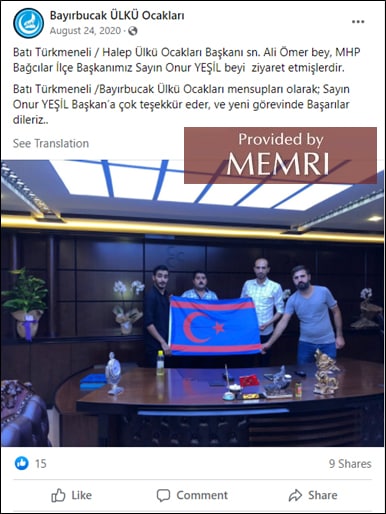
On August 5, 2020, the Bayırbucak Ülkü Ocakları Facebook page posted a photo of two masked men holding rifles, giving the Ülkü Ocakları salute, and standing in front of a Turkish flag. The post read: "Bayırbucak / Turkmen Mountains."

Other Instances Of Ülkü Ocakları Activity In Syria And The Middle East Generally
On September 18, 2016, the Facebook account of the Çarşamba branch of the Ülkü Ocakları posted a group of photos and wrote: "We are at Yayla Mountain with Tarık Sohta, commander of the Yavuz Selim Division. We are at the home of Tarık Sohta, the Sultan Selim Division commander who four years ago started the resistance in the Turkmen Mountain with four others and who fired the first bullet, and his friends. We are together with mujahideen who know the honor of the [Turkey-Syria] border, who know the honor of the homeland, who never withdraw, who are monuments of unshakeable faith. Do not withhold your prayers – may Allah be the friend and helper of them all." In several of the photos in the set men are seen with rifles, standing in front of tanks, and giving the Ülkü Ocakları salute.[67] On December 16, 2013, it was reported that Refik Eryılmaz, an MP representing the opposition CHP for Hatay province, which borders Syria, formally asked in parliament whether claims that, among other things, Tarık Sohta had traveled around Turkey to recruit fighters "from mosques, Islamic associations, and foundations" and gather ammunition and other equipment, were true.[68]
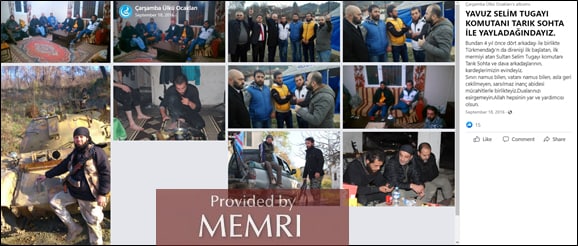
On August 14, 2016, the Facebook page of the Batman province branch of the Ülkü Ocakları shared an album of photos featuring fighters in Syria and wrote: "Commander Ömer Abdullah on the one hand, Commander Alparslan Çelik on the other... We never run out of valiant [fighters]... [they] are in Turkmen Mountain."[69] On December 6, 2015, Ülkü Ocakları director Olcay Kılavuz and director of the Kocaeli province branch of the Ülkü Ocakları İbrahim Özcan reportedly sent two shipping containers worth of aid gathered in Kocaeli to Ömer Abdullah, whom the article described as the commander of the Abdülhamid Han Division.[70]

A video titled "Ülkü Ocakları Convoy Of Aid Containers To Turkmen Mountain" and uploaded to the YouTube Channel of the Kahramanmaraş province branch of the Ülkü Ocakları on December 5, 2015, shows 23 trucks filled with supplies and marked with Ülkü Ocakları banners.[71] In October 2020, Kılavuz and Özcan had reportedly sent a convoy of 37 containers to Ömer Abdullah at Yayladağı, A Turkish town on the Turkey-Syria border.[72]
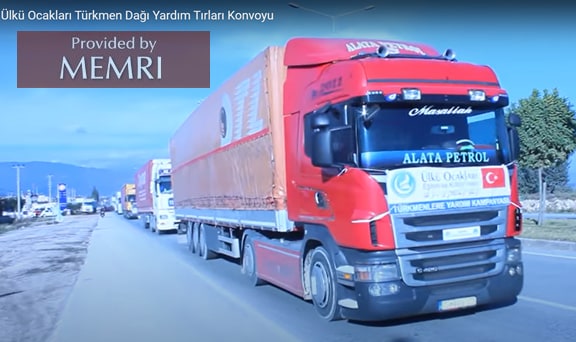
Fehim İsa, who is the general commander of the Sultan Murad Division, tweeted in response to news that the United States government may consider whether to categorize the Ülkü Ocakları as a terrorist organization: "As the Syrian Turkmens, we condemn this antagonistic behavior of the U.S. against human rights and freedom of expression. Our side is clear: long live the Ülkü Ocakları!"[73] İsa tagged MHP leader Devlet Bahçeli and Ülkü Ocakları general director Ahmet Yiğit Yıldırım.
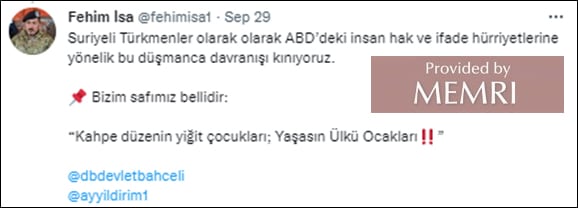
On May 14, 2020, a video surfaced online showing a group of armed masked men dressed in military fatigues. In the background is a flag often used by jihad groups. One of the men says: "The president of the Kayseri branch of the Ülkü Ocakları has invisible armies and brothers. One night they will come and in the neighborhood of Gazi, in Iraq, in Raqqa, wherever you are, and the account will be settled."[74]
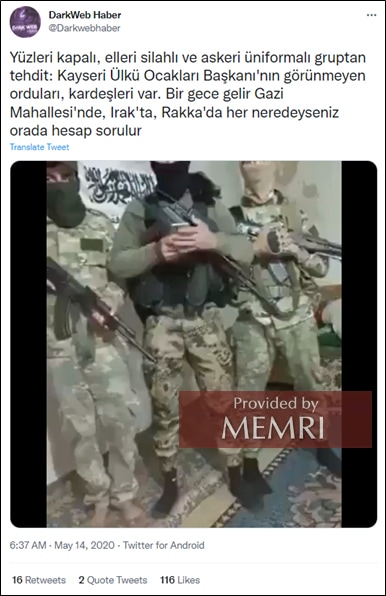
On March 28, 2020, it was reported that Salim Arduçlu, who had been a candidate to represent the MHP in İzmir province in the June 2018 general elections, had written on Facebook in the days preceding the report that Murat Polat of the İzmir Karşıyaka branch of the Ülkü Ocakları had been killed in a rocket attack alongside six other Turkmen fighters.News reports indicate that that Polat had been killed in Libya, but this is not clear from Arduçlu's post.[75] He reportedly later deleted the post, but it remains available online. Photos show Polat giving the Ülkü Ocakları salute and carrying a rifle.

Ülkü Ocakları Role In Turkish Government's 1995 Attempted Overthrow Of Azerbaijan Government
There is reporting of Ülkü Ocakları involvement in a 1995 attempt to overthrow the government of Azerbaijan. On June 7, 1992, Ebulfeyz Elçibey, leader of the Halk Cephesi party in Azerbaijan, was elected president of Azerbaijan and quickly perceived in Turkey, according to Turkish journalist Hakan Aksay, as "our man" in Azerbaijan. Elçibey was overthrown in a coup a year later on June 24, 1993, and replaced by Heydar Aliyev, the father of current Azerbaijan President Ilham Aliyev, who was seen as pro-Russia.
Hakan Aksay has written that for years, under the direction of Turkey's MHP and on the pretext of protecting the Halk Cephesi party, the "ülkücüleri" had been setting up camps in Azerbaijan as though preparing for war. It was under these conditions that two Azeri oppositionists who had fled the Azeri government and whose names one news report gives only as Fehmin and Ali, had dinner sometime in 1994 with then Turkish Prime Minister Tansu Çiller and State Minister Ayvaz Gökdemir. Together the group decided to overthrow the Aliyev government by giving money and weapons to Elçibey, who was in exile in Nahçıvan.
According to the plan reportedly prepared by Turkish intelligence, in case it looked as though the coup would fail, then Turkish President Süleyman Demirel would "warn" Aliyev of the attempted coup. In the end this is what happened, and the official Turkish government narrative is still something to the extent that "some dark forces that had infiltrated the [Turkish] government got involved in some unwanted events in Azerbaijan, and with Demirel's intervention a breakdown in Turkish-Azeri relations was prevented."[76] Today the government of Azerbaijan lists the Ülkü Ocakları as a terrorist organization.[77] In the absence of a major infraction such as involvement in an attempt to overthrow the Azeri government, such a designation would be surprising since Ülkü Ocakları ideology emphasizes the ancestral bond between Turkic countries such as Turkey and Azerbaijan.
Kutlu Savaş, head of the inspection committee of Turkey's Office of the Prime Minister, provided details of the attempted coup in a government report prepared following the Susurluk incident.[78] Twelve pages of this report that had been censored were included years later in an indictment in the Ergenekon trial.[79] The report names the following men as being involved in the attempted coup: Ambassador to Azerbaycan Altan Karamanoğlu; Ertuğrul Güven, undersecretary for the Milli İstihbarat Teşkilatı (MİT), Turkey's national intelligence service; Embassy Undersecretary for Religion Abdülkadir Sezgin; Military Attache Engin Alan; Ferman Demirkol, who was an advisor to Azeri parliament, an employee of the Turkish Cooperation And Coordinaton Agency and an MIT employee; MİT Foreign Intelligence Unit Head Yalın Ertan; and Undersecretary For the Office of Prime Minister Ali Naci Tuncer. Mehmet Ağar, who was founder and leader of Turkey's Democrat Party, Turkey's justice minister from March through June 1996, and interior minister from June to November of the same year, was reportedly involved in the attempted coup as well.[80]
Aksay's report of Ülkücü military training camps in Azerbaijan during that period align with the reporting of an Azeri security official. On July 12, 2003, Turkey's Yeni Şafak daily, under the headline "Türkeş Had A Guerilla Camp Set Up In Azerbaijan," reported on a book called "Check-Mate, Realities of Azerbaijan From The Pen Of A Lieutenant Colonel,"[81] written by Azeri retired lieutenant colonel Novruz Hasan Bozalganlı, who was the head of security for the Azeri city of Tovuz.[82]
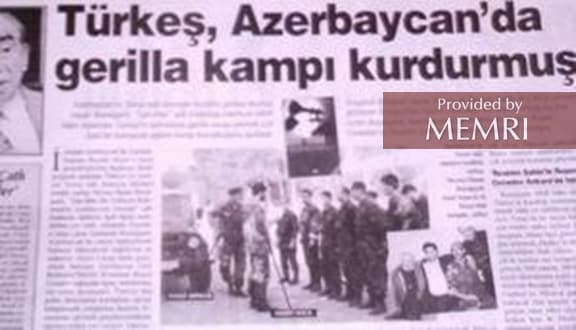
Bozalganlı says Alparslan Türkeş, who was then head of the MHP, established a military training camp to wage a guerilla war. He describes the military activities of the "ülkücüler" in Azerbaijan, including the military operations in Armenian territory by the teams trained at these camps, as well as how some "ülkücüler" were killed in these operations. Bozalganlı says that then Ülkü Ocakları director Atila Kaya travelled to Azerbaijan and said that Türkeş had instructed him to come to Azerbaijan and that he was there to train young men who would come from Turkey, Azerbaijan, and the Turkic world to fight in the Karabağ war that was happening between Azerbaijan and Armenia. Bozalganlı describes how he brought Kaya to a Soviet-era scout camp no longer in use that was 40 kilometers outside of Tovuz, near the Azerbaijan-Armenia border. Kaya approved of the location and returned to Turkey to inform Türkeş. Meanwhile Bozalganlı began setting up electricity, natural gas, a kitchen, barracks, and other amenities at the camp. Kaya returned later with about 25 people. Eight were from Elçibey's Halk Partisi, while the rest were from Turkey. They began training fighters with this small group, which increased over time. The fighters reportedly worked to obstruct PKK activities in Azerbaijan as well.

The September 6-12, 2005 issue of the weekly Turkish magazine Haftalık supplements Bozalganlı's account in its report on the "Wind Unit," which it described as "Alparslan Turkeş's 500 secret warriors" and "a special unit of 500 people established by Alparslan Türkeş en route to the Azeri-Armenian war." The magazine goes on: "A unit that today no one knows changed the destiny of the 1991-1994 Karabağ war between Azerbaijan and Armenia. The Wind Unit, which comprised 500 Ülkücü and specially trained soldiers, fought a lot against Armenian militias. Azerbaijan was routed after the Wind Unit, which was created at Türkeş's instruction, withdrew after being given a secret order." The unit was under the command of Yusuf Ziya Arpacık.

Arpacık was photographed extensively during the fighting between Azerbaijan and Armenia in the early 1990s. He had been Alparslan Türkeş's bodyguard and following the 2003 U.S. invasion of Iraq, he went to Kirkuk to organize the defense of the Turkmens there.[83]

Arpacık led the "Wind Unit" in Azerbaijan in the 1990s.

Arpacık was Türkeş's bodyguard.

Arpacık's current Facebook profile picture.
Arpacık has been described as a "known Ülkücü,"[84] and today promotes the Ülkü Ocakları on social media.[85] On June 6, 2020, Arpacık wrote on Facebook about the opening of a new Ülkü Ocakları district building for Istanbul.

On March 23, 2020, he posted an Ülkü Ocakları graphic in support of elderly Turks forbidden from leaving their homes as part of Turkey's COVID-19 policy.
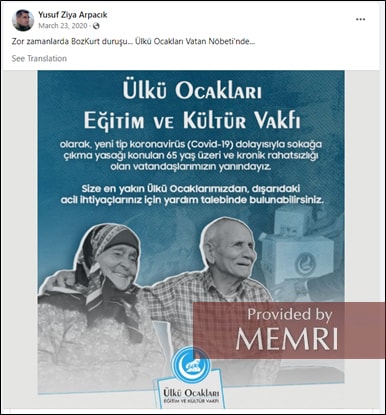
The "Wind Unit" In The Syria War
Talking about Azerbaijan, Arpacık said in a TV appearance uploaded to YouTube on December 28, 2018: "We ülkücüler went [to Azerbaijan] to help, for purposes of humanitarian aid, for purposes of military aid."[86] Though the video was titled "The Wind Unit is on the Syrian border," Arpacık did not say anything about the presence of the Wind Unit or other Ülkü Ocakları fighters in Syria. Three days later, on December 31, Facebook user Ülkügülü, which has posted content featuring Ülkü Ocakları martyrs such as Mustafa Pehlivanoğlu, posted a photo and wrote: "The Wind Unit, which Leader Alparslan Türkeş established, is on the Syrian border awaiting instructions and commands from the state." The photo features four pickup trucks with emblems that are the same as the Ülkü Ocakları emblem but read "Wind Unit" where "Ülkü Ocakları" is usually written. A heavy weapon appears to be mounted on the back of one of the vehicles, and a rifle appears partially in the frame.[87] The buildings and mountains visible in the picture are consistent with what one would expect to see on the Turkish side of the Turkey-Syria border.
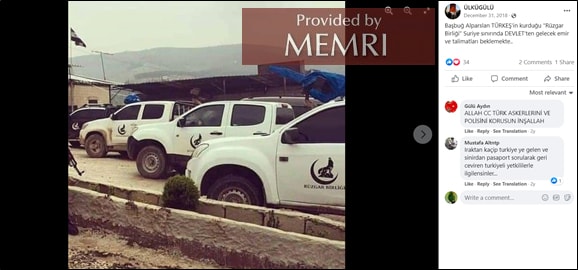
The Sondakika Edremit Facebook page posted an unedited version of the same photo, which shows a man standing with a rifle, as well as the four pickup trucks with emblems that are the same as the Ülkü Ocakları emblem but read "Wind Unit" where "Ülkü Ocakları" is usually written.[88] Sondakika is a news outlet, and Edremit is a district of Turkey's Balıkesir province.
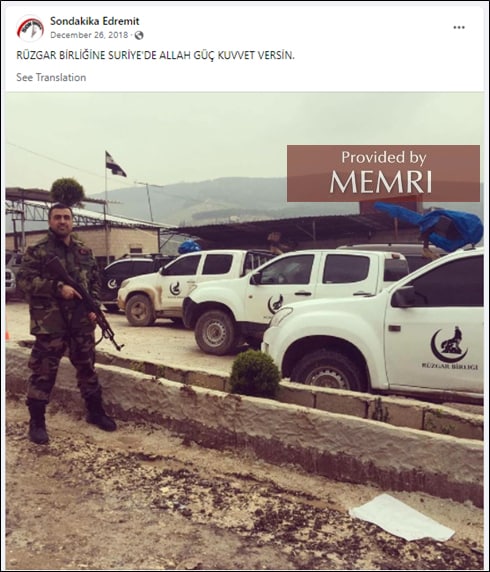
Other photos tweeted on April 10, 2018, show fighters bearing weapons and standing in front of pickup trucks bearing emblems that are the same as the Ülkü Ocakları emblem but read "Wind Unit" where "Ülkü Ocakları" is usually written, and giving the Ülkü Ocakları salute. The trucks also have emblems of the Free Syrian Army and the name Al-Vakkas Tugayı ("Al-Vakkas Division"). The tweet reads: "A thousand greetings to those who do not bow their heads. #WindUnit #TheyDidNotBowTheirHeads #Afrin." "They Did Not Bow Their Heads" is the name of a book[89] by Arpacık about the fighting between Azerbaijan and Armenia in the 1990s, while YZA are Arpacık's initials.


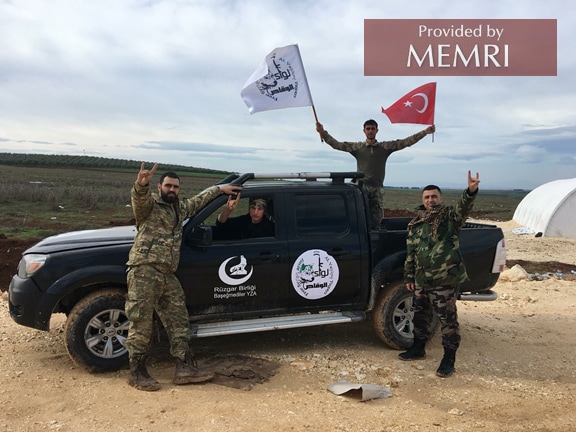
On November 26, 2019, Arpacık posted a photo on Facebook and wrote: "Greetings to the night guards in Syria."[90] The photo featured six men, two wearing military vests, standing in front of a vehicle bearing the emblem of the Ülkü Ocakları and the words "Wind Unit," "They Did Not Bow Their Heads," and the letters "YZA." As mentioned, "They Did Not Bow Their Heads" is the name of a book by Arpacık about the fighting between Azerbaijan and Armenia in the 1990s, while YZA are Arpacık's initials.
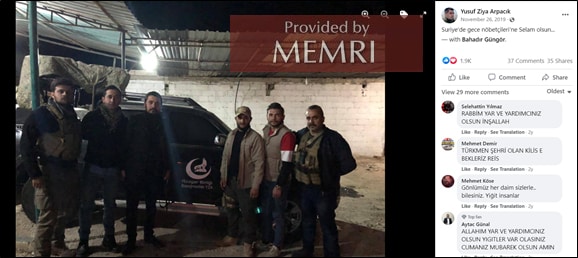
Shamil Basayev
Ülkü Ocakları outlets have commemorated the anniversary of the death of slain Chechen militant leader Shamil Basayev. Basayev led the June 1995 raid on Budyonnovsk hospital in Russia that killed 129 people,[91] the September 2004 raid on the Beslan school that killed 330 people, a 2002 raid on a Moscow theater that killed 170 people,[92] two December 2003 bombings in southwest Russia and Moscow that killed 46 and six people, respectively,[93] sent suicide bombers to blow up two Russian airliners in mid-flight in 2004, killing 90, and bombed a Moscow metro station that killed 10 the same year. He led and directed many other attacks as well.[94] He was killed in an explosion during an arms deal on July 10, 2006.[95] The State Department listed Basayev as a terrorist under Executive Order 13224 in 2003 and later delisted him 2011.[96]
There are four main reasons why some Turks, especially the Ülkü Ocakları, support Basayev. Following Russia's 19th-century conquest of the Ottoman-controlled Caucasus, Circassians, an umbrella term for members of a collection of linguistic groups from the north Caucasus of which Chechens are one,[97] migrated from the Caucasus into Anatolia and other parts of the Ottoman Empire. Seeking upward mobility, Circassians distinguished themselves in the Ottoman bureaucracy and in the military cadre.[98] As is often the case with migrants, they later became especially nationalistic on behalf of their new homeland, and today vote for the MHP in a greater proportion than they are represented in the general population.[99] Another reason for Turkish support for Basayev is because the Ottomans fought 12 wars against the Russians, and this five-century animosity has led to an inclination among many Turks to support anyone who opposes Russia, as Basayev did.
Chechens are also predominantly Muslim, and the period during which Basayev was active, from the 1990s to when he was killed in 2006, overlaps with the 1992-1995 Bosnian War and the 1991-2001 Yugoslav Wars, both of which included the killing of Muslims. In particular the July 1995 Srebrenica massacre, in which the Bosnian Serb Army massacred 8,000 Bosnian Muslim men and boys in the town of Srebrenica, remains in the consciousness of many Turks. Though Basayev was of course involved in a geographically separate conflict, some Turks view him as one who fought on behalf of oppressed Muslims, and today there are Shamil Basayev Avenues in Turkey's Mersin and İğdir provinces.
However, the primary reason for Ülkü Ocakları support for Shamil Basayev may be Basayev's fighting side-by-side with Arpacık's Wind Unit in the First Nagorno-Karabagh War from 1988-1994. Armenian journalist Dr. Khatchig Mouradian, who is also a lecturer at Columbia University, quoted Azeri Colonel Azer Rustamov, who fought in the war, as saying that "hundreds of Chechen volunteers rendered us invaluable help in these battles led by Shamil Basayev and Salman Raduev."[100] If true, this means that Basayev was leading a force of Chechen fighters alongside the Wind Unit under Yusuf Ziya Arpacık's command and against the Armenian military. Basayev reportedly withdrew his fighters and returned to Chechnya in 1993.[101]
Many Ülkü Ocakları outlets have commemorated the anniversary of Basayev's death. The Zeytinburnu branch of the Ülkü Ocakları commemorated his death on July 10, 2019, writing: "We remember with mercy and gratitude the legendary commander, the eagle of the Caucasus, Shamil Basayev, on the anniversary of his martyrdom. May his soul be glad."[102] The post included a graphic featuring the emblem of the Ülkü Ocakları, an image of Basayev, and a quote of his: "If a cause is not worth dying for, it is not worth living for."
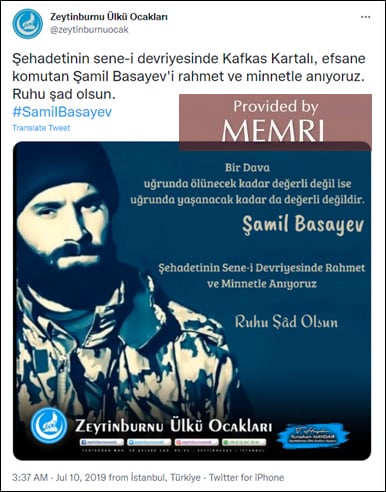
The Güngören branch of the Ülkü Ocakları wrote on July 10, 2018, a similar message: "We remember with mercy and gratitude the legendary commander, the eagle of the Caucasus, Shamil Basayev, on the anniversary of his martyrdom. May his soul be glad and his place be paradise."[103] The post included a graphic featuring an image of Basayev and the emblem of the Ülkü Ocakları. The Istanbul University branch of the Ülkü Ocakları tweeted the same graphic on the same day.[104]

On the same day, the Kocaeli branch of the Ülkü Ocakları wrote: "We remember once more with mercy and prayer the anniversary of the martyrdom of Shamil Basayev, the eagle of the Caucasus, whose name is a symbol of the Chechen resistance." The post included a graphic featuring the emblem of the Ülkü Ocakları, an image of Basayev and a quote attributed to him: "Since you will not have two deaths, let that one death be valiant."[105]
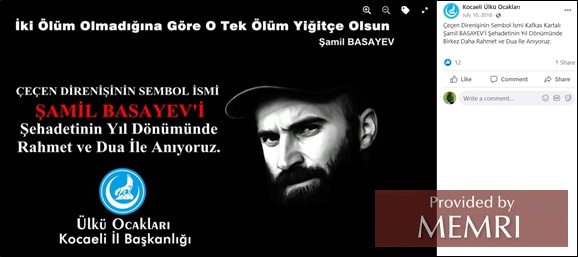
On the same day, the Kahramanmaraş branch of the Ülkü Ocakları wrote on Facebook: "We remember with mercy the annversary of the death of Shamil Basayev, the valiant commander who is the symbol of faith, jihad, and martyrdom." The post included a graphic featuring the emblem of the Ülkü Ocakları, an image of Basayev, and a quote attributed to him: "One whose sister has not been raped by an unbeliever, whose son has not had his throat cut by an unbeliever, cannot understand jihad... A life spent in jihad is much better than a life of slavery. It does not matter when we will die, but how. What falls to us is to die with our honor. We are grateful to the Turkish nation to whom we have entrusted our wives and our children."[106]
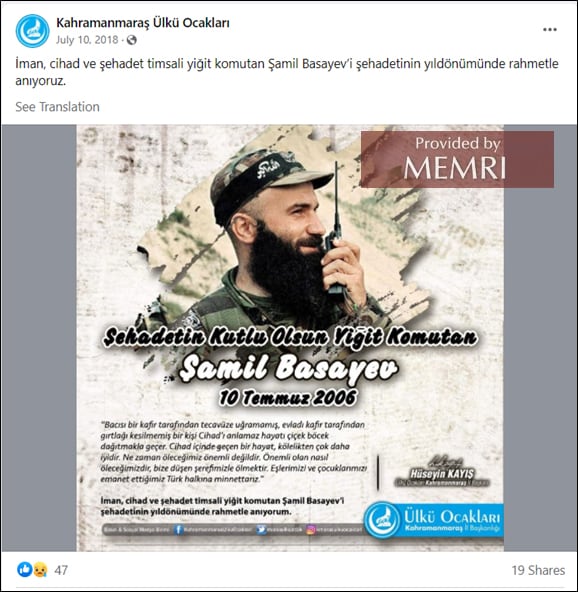
On the same day, the Karaisalı branch of the Ülkü Ocakları wrote: "A cause that is not worth dying for is not worth living for." The post included a graphic featuring the emblem of the Ülkü Ocakları, an image of Basayev the same quote attributed to him.[107]
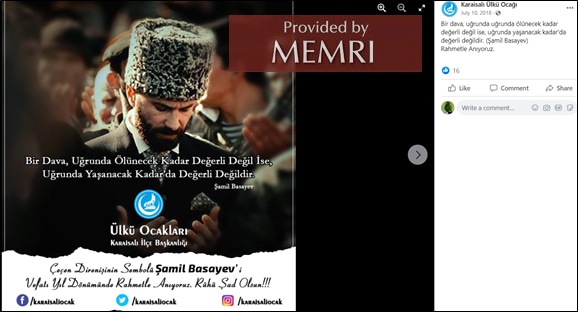
The 1978 Maraş Massacre And The Attempted Assassination Of The Pope
A January 17, 1979 report by the Milli İstihbarat Teşkilatı (MİT), Turkey's national intelligence service, says that a 1978 attack on Alevi Kurds in the city of Kahramanmaraş in which between more than 100 people were killed,[108] was planned two to three weeks before at a meeting between the MHP political organization for Maraş province and members of the Ülkücü Gençlik Derneği, a predecessor to the Ülkü Ocakları.[109]
Mehmet Ali Ağca, who shot and wounded Pope John Paul II in May 1981, was known to be a member of the Ülkü Ocakları. Erol Aydağ, who founded the Malatya branch of the Ülkü Ocakları, said of Ağca that "he did not come to the Ülkü Ocakları very often. He would come and go every once in a while... He did not seem so involved in fighting. He was the calm child of a poor family in search of bread. He worked in the tea room at the station." When he heard of the February 1979 murder in Istanbul of journalist Abdi İpekçi, for which Ağca was imprisoned, Aydağ said: "We were surprised, but I did not believe it... We were suprised about the [attempted] assassination of the pope as well. Ağca was not such an active guy."[110]
Ağca said in 1983 that the KGB was involved in the assassination attempt, a claim that the Soviet Union denied at the time, calling it "threadbare propaganda."[111] At a court hearing in 1985, Ağca said: "The order to kill the pope came from the Soviet Embassy in Sofia... We Gray Wolves acted with the complicity of Bulgarian functionaries in Rome that included Aivazov, Kolev, and Antonov... The first secretary of the Soviet Embassy in Sofia paid three million [West German] marks [then $1.2 million] to the head of the Gray Wolves, Musa Serdar Celebi, through Bekir Celenk." Two of the men Ağca named, Todor Aivazov and Lt. Col. Zhelyo Kolev Vassilev, were employees of the Bulgarian Embassy in Rome who had returned to Bulgaria. The third man he named, Sergei Ivanov Antonov, was the Rome manager for Bulgaria's national airline.[112] Agca said that the name of the Soviet official who had made the payment was "Milenkov," that he was 40-45 years old, blonde and rugged-looking, and that he could identify the man if given photos of Soviet diplomats.
After being convicted and sentenced to life in prison in 1981, Ağca was released in 2000 and extradited to Turkey, where he was again imprisoned for crimes from 1979, before being released in 2010. He later claimed in his memoirs that Ayatollah Ruhollah Khomeini of Iran had ordered the assassination, that he had been trained by Mohsen Rezai, and that he had lied previously about the Soviet connection. He also claimed that he was Christ and that the world would come to an end in this century.[113] The Turkish military determined in an assessment that Ağca had "antisocial personality disorder" and was therefore unfit for compulsory military service.[114]
Government Policies Against The Ülkü Ocakları Around The World
Many governments around the world have acted against the Ülkü Ocakları. The government of Kazakhstan designated the Ülkü Ocakları as a terror organization in 2005. The Taliban and the Muslim Brotherhood joined the list the same day. The law also cited the May 1, 1977 attack on a May Day demonstration in Istanbul in which 34 people were killed.[115] As has been mentioned, the government of Azerbaijan lists the Ülkü Ocakları as a terrorist organization. In December 2018, Austria passed a law banning the use of the Ülkü Ocakları salute.[116] France banned the group entirely in November 2020.[117] Russian lawmaker Andrea Klisas called in 2015 for the group to be banned in Russia.[118]
The Ülkü Ocakları have Facebook pages indicating the group's presence in the U.S.,[119] Australia,[120] Austria,[121] Germany,[122] the Netherlands,[123] Sweden,[124] and Belgium,[125] among others. Members of the group marched in the 2016 Turkish Day parade in New York.[126] In 2015 the group held its fourth annual Mother's Day event in New Jersey.[127] On April 23, which is celebrated as National Sovereignty and Children's Day in Turkey, in 2015, the group's American branch held an event at which children wearing military camouflage-colored pants and t-shirts marched and did pushups.[128]

Ülkü Ocakları members marching in the 2016 Turkish Day Parade in New York City.
The Facebook page of the Ülkü Ocakları of America has 5,184 followers.
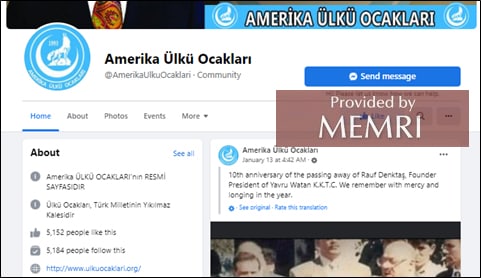
The Facebook page of the Ülkü Ocakları of Victoria, Australia, has 1,043 followers.
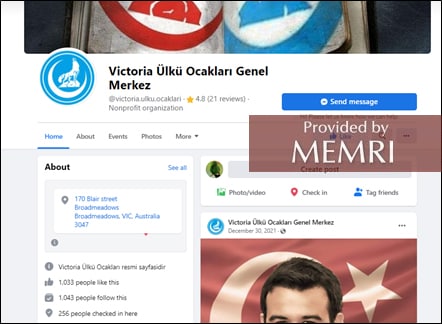
The Facebook page of the Ülkü Ocakları of Germany has 2,286 followers.
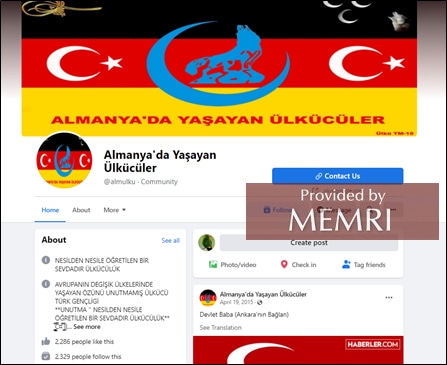
The Facebook page of the Ülkü Ocakları of the Netherlands has 1,834 followers.

The Facebook page of the Ülkü Ocakları of Sweden has 2,783 followers.

The Facebook page of the Ülkü Ocakları of Belgium has 2,200 followers.
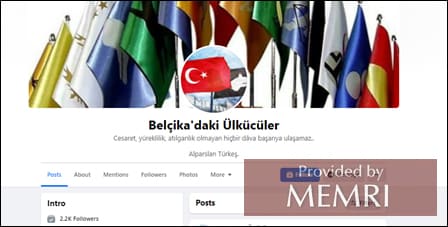
Conclusion
Members and leaders of the Ülkü Ocakları, which presents itself as an "educational and cultural foundation," have fought in Syria and Azerbaijan outside of conventional Turkish military forces. Shipments marked with the group's official emblem have reached armed groups in Syria, while the group's official outlets in Turkey have commemorated by name those killed in the fighting.
In the 1990s Ülkü Ocakları appears to have sent fighters to train and fight in the war between Azerbaijan and Armenia, and to play an unclear role in an attempted coup against the government of Azerbaijan. Its fighters, under the command of Yusuf Ziya Arpacık, fought against the Armenian army and alongside Chechen fighters under the command of Shamil Basayev, who later went on to lead a terror campaign that killed hundreds if not thousands of Russians. These fighters under Arpacık's command were called the "Wind Unit," a name later used by fighters in Syria. Today Ülkü Ocakları outlets regularly commemorate the anniversary of the death of Shamil Basayev.
The group has been implicated in left-right street fighting and violence in Turkey in the 1970s, particularly the 1978 attack in the city of Kahramanmaraş in which between more than 100 people were killed. The Ülkü Ocakları is an arm of the Milliyetçi Halk Partisi (MHP), which is the smaller of two parties in a coalition governing the country, the other being President Recep Tayyip Erdoğan's AKP. Today social media pages indicate the group has thousands of members and supporters in various countries across the West including the U.S., Australia, Austria, Germany, the Netherlands, Sweden, and Belgium.
*A. Smith is Director of the MEMRI Turkish Media Studies Project.
[1] Turanism, also called pan-Turanism and pan-Turkism, is a political philosophy whose adherents seek to unite the world's Turkic peoples, who live primarily in Turkey, the Caucasus, and Central Asia. While the origin of the idea of a language group, and by extension a national group, uniting these peoples can be traced to major Enlightenment-era philosopher and mathematician Gottfried Wilhelm Leibniz, the idea began to spread among Ottoman military officers and elites living in Imperial Germany in the 1870s. The question of the precise role of this idea in the policy and philosophy of Mustafa Kemal Atatürk, founder of the Republic of Turkey, is a subject of debate, but some of the policy and rhetoric of Turkish President Recep Tayyip Erdoğan and his ruling AKP reflects Turanist influence. See also MEMRI Special Dispatch No. 9017 Amid Azerbaijan-Armenia Fighting, Turkish Dailies Propose 'Turkic NATO': 'The Turkic States Must Unite', November 9, 2020.
[2] Dw.com/tr/alparslan-t%C3%BCrke%C5%9F-bir-hitler-sempatizan%C4%B1yd%C4%B1/a-55660972, November 19, 2020.
[3] Kemal Bozay: "Graue Wölfe heulen wieder — Türkische Faschisten und ihre Vernetzung in der BRD", Münster 1997, Page 52.
[4] Yenicaggazetesi.com.tr/mobi/yazi-arsivi-372685h.htm, April 5, 2012.
[5] Dergipark.org.tr/en/download/article-file/541530, May-June 2018.
[6] Artigercek.com/yazarlar/ahmetnesin/mhp-genel-baskanlari-ve-terorizm, June 22, 2020.
[7] Dergipark.org.tr/tr/download/article-file/107109, 2015.
[8] Ulkuocaklari.org.tr, accessed January 20, 2022.
[9] One example is the spelling tengri, which many Ülkü Ocakları supporters use. Most Turks do not prefer to use even the universalist term "tanrı" when referring to God but instead use "Allah." Tengri is an alternative spelling of tanrı, making it still further removed from Islam.
[10] Islamansiklopedisi.org.tr/selcuk-bey, accessed February 1, 2022.
[11] Bianet.org/bianet/siyaset/124685-dortyol-da-saldiriyi-ulkuculer-yonetti-iddiasi, September 8, 2010; gercekhaberajansi.org/fransada-kurt-kultur-dernegine-saldiri-4-yarali, April 4, 2021.
[12] Bianet.org/bianet/insan-haklari/175162-ulku-ocaklari-baskani-ermenilere-nefret-soyleminden-ceza-aldi, May 25, 2016.
[13] Ensonhaber.com/politika/ulkuculer-kemal-kilicdaroglunu-dovmus, May 24, 2010.
[14] Hurriyet.com.tr/gundem/cinli-sanip-korelilere-saldirdilar-29460272, July 5, 2015; Youtube.com/watch?v=LcL6s3vA1oA, July 4, 2015.
[15] There has been conjecture that the Ülkü Ocakları were involved in a 2015 bombing in Thailand. After the country's PM announced on July 8, 2015, that it would forcibly return 100 Uyghurs living in Thailand to China, Ülkü Ocakları members attacked the Thai Consulate in Istanbul, breaking its windows and doors. On August 17, a bomb exploded in downtown Bangkok, killing 20 people and injuring 125. The police eventually settled on a man who did not speak Thai and was renting five rooms in a Muslim area of town. He was arrested with a false Turkish passport and bomb-making equipment. Security analyst Anthony Davis said that given the circumstances he thought the Ülkü Ocakları could be behind the attack. Davis mentioned the attack by Ülkü Ocakları supporters against the Thai Consulate in Istanbul the month before. This explanation has since been repeated in many other news outlets, generally quoting Davis himself. While many outlets have written on the bombing as though it were a proven fact that the bomber was a member of the organization, MEMRI has found no evidence of a connection between this man and the Ülkü Ocakları. It later came to light that the bomber was himself not Turkish but ethnically Uyghur and had lived in Turkey. The name in the false passport was Adem Karadağ, but his name was later given as Bilal Mohammed. The man also said he had taken orders from one Abdullah Abdurrahman. Adem Karadağ is also the name of one of four Turks reported kidnapped in Libya on April 30, 2019. It is unclear whether there is any connection between the two. There is also a second man involved in the Bangkok bombing whose name is Mieraili Yusufu, which is not a Turkish name. Birgun.net/haber/ulkuculer-bu-kez-de-tayland-konsolosluguna-saldirdi-84413, July 9, 2015; Smh.com.au/world/bangkok-bombing-who-are-the-turkish-terrorist-group-the-grey-wolves-20150830-gjavjz.html, August 30, 2015; Forbes.com/sites/susancunningham/2015/08/24/thailands-shrine-bombing-the-case-for-turkeys-grey-wolves/?sh=64b4454b5d3f, August 24, 2015; Haberler.com/bangkok-bombacisi-turk-degil-uygur-cikti-7736321-haberi, October 1, 2015; Hasgazete.com/libyada-4-turk-kacirildi-3956, April 30, 2019; Ctc.usma.edu/the-riddle-of-the-bangkok-bombings, October 2014.
[16] Youtube.com/watch?v=6OAYozLGQnE, August 6, 2013, Youtube.com/watch?v=VTWCRjAcMys, October 9, 2014; Youtube.com/watch?v=pfWxiMJPtaw, July 23, 2017; Youtube.com/watch?v=MEPq4rqFHdo, January 12, 2014; Youtube.com/watch?v=MgLbEMTpDOQ, January 12, 2014; Youtube.com/watch?v=EOgq8Q_7st8, February 27, 2017; Youtube.com/watch?v=Ggyis0Zu_Hc, January 12, 2014; Youtube.com/watch?v=qbZEZcSJLRw, May 1, 2021; Youtube.com/watch?v=RaHAfGcXJkY, December 29, 2014; Youtube.com/watch?v=ctW-qWKqd_U, January 12, 2014.
[17] Youtube.com/watch?v=5nwLemMKHt4, October 9, 2014.
[18] Youtube.com/watch?v=q8KGSSpWXVs, October 30, 2017; Youtube.com/watch?v=udf4Ta3kg34, November 3, 2017.
[19] Ulkuocaklari.org.tr/dergiler/dergiler/uakasim2020-turkce.pdf, November 2020; kitapyurdu.com/kitap/dokuz-isik/27612.html, accessed January 19, 2022.
[20] Lekolin.org/sultan-murat-tugayi-gercegi, August 22, 2015; Twitter.com/stumeni, accessed February 1, 2022.
[21] Yenisafak.com/dunya/sultan-murat-tumen-komutanindan-firat-kalkani-aciklamasi-2785141, August 24, 2017.
[22] Dunyabulteni.net/tarih-dosyasi/hatay-nasil-turkiye-ye-katildi-h118849.html, January 10, 2019.
[23] Indigodergisi.com/2015/11/bayir-bucak-turkmenleri-kimdir-turkmen-dagi-nerede-bayirbucak-turkmenler-kizildag-suriye-esad-isid-deas-daes-rusya, November 26, 2015.
[24] Twitter.com/Percligia/status/1255619957687287810, April 29, 2020.
[25] Haber.sol.org.tr/devlet-ve-siyaset/mhpnin-suriyedeki-militanlarla-baglantisi-haberi-91614, April 28, 2014.
[26] Youtube.com/watch?v=FWUx1Z95gLA, August 16, 2017.
[27] Timeturk.com/tr/2014/04/22/turkmen-komutan-adil-orli-isid-icin-artik-susmayacagiz.html, April 2014.
[28] Habererk.com/turk-dunyasi/turkmen-komutan-adil-orli-yaralandi-h33119.html, June 11, 2017.
[29] Youtube.com/watch?v=ATyF0_ZPhOs, December 22, 2016.
[30] Youtube.com/watch?v=t6_1hWmu1WY, accessed July 21, 2014.
[31] Mobile.twitter.com/pendikocak34/status/1242361452847079429, March 24, 2020.
[32] Twitter.com/metehanyurtbasi, accessed November 22, 2021.
[33] Twitter.com/olcaykilavuz/status/977498261257965568, March 24, 2020.
[34] Twitter.com/olcaykilavuz/status/580439261704548352, March 24, 2015.
[35] Twitter.com/olcaykilavuz/status/1374741546654957568, March 24, 2021.
[36] Twitter.com/giresunocak/status/1374407526154792973, March 23, 2021.
[37] Twitter.com/turkmenajans, accessed January 19, 2022.
[38] Twitter.com/ibrahimbozanTR/status/1373557762622377987, March 21, 2021.
[39] Gemlikhabergazetesi.com/haber/ulku-ocaklari-iftari-ilgi-gordu-35901.html, June 12, 2017.
[40] Facebook.com/TurkmeneviUlkuOcaklari/posts/1468904550070989, July 22, 2015.
[41] Haberturk.com/gundem/haber/1106537-suriyede-hayatini-kaybeden-burak-misinci-topraga-verildi, July 23, 2015.
[42] Haber.sol.org.tr/medya/dhaya-gore-lazkiyede-suriye-ordusunun-oldurdugu-mhpli-sehitmis-123706, July 22, 2015.
[43] Gazetevatan.com/gundem/suriyede-olen-ulkucuyu-mhpliler-ugurladi-834229, July 23, 2015.
[44] Twitter.com/aliyetgin2023/status/623119781097512962, July 20, 2015.
[45] Hurriyet.com.tr/dunya/ulkucu-genc-lazkiye-de-olduruldu-29597264, November 5, 2021.
[46] Facebook.com/fahribozgeyik27/photos/%C3%BClk%C3%BCc%C3%BC-hareket-%C5%9Fehitler-vermeye-devam-ediyormhp-fatih-il%C3%A7e-te%C5%9Fkilat%C4%B1ndan-garda%C5%9F%C4%B1/1015219861883159, January 26, 2016.
[47] Twitter.com/fahribozgeyik; inisiyatif.org/yonetim-kurulu-14, accessed November 22, 2021.
[48] Twitter.com/fahribozgeyik/status/1235293154510807041, March 4, 2020.
[49] Facebook.com/PendikUlkuOcaklari/photos/a.638646929517560/1605764852805758, January 26, 2018.
[50] Facebook.com/AvcilarOcak/photos/a.709003312448870/3366472270035281, January 26, 2020; youtube.com/watch?v=OpFYfZ0WQmQ, November 2, 2021.
[51] Facebook.com/esenyurtocak/photos/a.577496485633066/3514016115314407, January 26, 2021.
[52] Facebook.com/watch/?v=953982421317802, February 25, 2016.
[53] Eminhaber.org/sehit-ferhat-tule-sultangazide-topraga-verildi.html, February 26, 2016.
[54] Gazetevatan.com/gundem/mhpli-eski-baskanin-oglu-iside-karsi-savasacak-656710, July 9, 2014.
[55] Youtube.com/watch?v=CwRjTHJk3U0, November 25, 2015.
[56] Facebook.com/2ndcoastaldivt, accessed February 1, 2022.
[57] Milliyet.com.tr/gundem/rusya-nin-hedefindeki-alparslan-celik-ten-adana-ziyareti-2204653, March 5, 2016.
[58] Facebook.com/AlparslanCelik1071, accessed November 23, 2021.
[59] Twitter.com/CelikAlparslan, accessed November 23, 2021.
[60] Twitter.com/celikalparslan/status/1374424853567053835, March 23, 2021.
[61] Youtube.com/watch?v=eKNE5IRsLmE, November 22, 2015.
[62] Haber7.ru/alparslan-celik-rusyaya-meydan-okudu.html, March 7, 2016.
[63] Cumhuriyet.com.tr/haber/rus-pilotu-oldurdugu-iddia-edilen-alparslan-celik-tutuklandi-509358, April 3, 2016.
[64] Dailysabah.com/investigations/2017/05/22/alleged-killer-of-russian-pilot-sentenced-to-5-years-in-prison, May 22, 2017.
[65] Facebook.com/profile.php?id=100063102616314, accessed November 22, 2021.
[66] Facebook.com/groups/334568598257737, accessed November 22, 2021.
[67] Facebook.com/media/set/?set=a.1322822827736365&type=3, September 18, 2016.
[68] Iskenderungazetesi.com/tarik-sohta-turkiyede-adam-ve-silah-ariyor-mu, December 16, 2013.
[69] Facebook.com/72behcet/photos/?tab=album&album_id=1126986787358477, accessed January 20, 2022.
[70] Yakintakipgazetesi.com/haber/kocaeli-ulku-ocaklari-yardimlari-teslim-etti_h13941.html, December 6, 2015.
[71] Youtube.com/watch?v=AfT1wEXqemk, December 5, 2015.
[72] Kocaelihaberdunyasi.com/ozcan-konvoyumuzu-ve-emanetleri-teslim-etti, October 20, 2020.
[73] Twitter.com/fehimisa1/status/1443259569023684615, September 29, 2021.
[74] Twitter.com/Darkwebhaber/status/1260881797560360961, March 14, 2020.
[75] Yeniakit.com.tr/haber/izmirli-ulkucu-murat-polat-sehit-oldu-1149720.html, March 28, 2020.
[76] T24.com.tr/yazarlar/hakan-aksay/mudahaleci-turk-dis-politikasi-ozbekistan-azerbaycan-suriye-2,5577, September 5, 2012.
[77] Radikal.com.tr/yazarlar/ali-kayalar/herkesin-teroristi-kendine-1514228, February 2, 2016.
[78] On November 3, 1996, in Susurluk, a town in Turkey's Balıkesir province there was a car crash after which tree men were found to be riding in the same car: Huseyin Kocadağ, a senior police official; Abdullah Çatlı, a wanted right-wing militant; and Sedat Bucak, a Kurdish politician. Kocadağ and Çatlı were killed in the crash, while Bucak had a broken leg and a fractured skull. The incident is famous in Turkey for its revelations of connections between the country's political leadership, military, and organized crime circles. This network is generally referred to in Turkish as the "deep state."
[79] The Ergenekon trials, which ran from 2008 to 2016, were high-profile cases against 275 people accused of plotting against the Turkish government.
[80] For more on Mehmet Ağar, see MEMRI Special Dispatch No. 9340 Turkish Organized Crime Boss: Young Female Journalist Found Dead In 2019 Had Reported To Authorities That AKP MP Had Raped Her, May 17, 2021; and MEMRI Special Dispatch No. 9358 Turkish Organized Crime Boss: To Evade DEA And Ship Cocaine To Middle East, Erkan Yıldırım, Son Of Former Prime Minister And Parliament Speaker Binali Yıldırım, Close Friend Of Interior Minister Süleyman Soylu, Recently Established 'New Headquarters' In Venezuela, May 26, 2021.
[81] Kitapyurdu.com/kitap/sahmat-bir-yarbayin-kaleminden-azerbaycan-gercegi/50117.html&filter_name=Novruz+Hasan+Bozalganl%C4%B1, accessed December 6, 2021.
[82] Yenisafak.com/gundem/turkes-azerbaycanda-gerilla-kampi-kurdurmus-2675392, July 12, 2003.
[83] Haber61.net/siyaset/turkesin-fedaisi-gozaltina-alindi-h84883.html, June 2, 2011.
[84] T24.com.tr/haber/17-ulkucuye-bahceliye-provokasyondan-gozalti,148429, June 1, 2011.
[85] Twitter.com/yusufziyarpacik, accessed January 19, 2022.
[86] Youtube.com/watch?v=nTZpkLxM36U, December 28, 2018.
[87] Facebook.com/UlkuGuluTC/photos/a.596868290404332/2013232265434587, December 31, 2018.
[88] Facebook.com/sondakikaedremit/posts/1294275457386384, December 26, 2018.
[89] Kitapyurdu.com/kitap/basegmediler/351183.html, accessed December 6, 2021.
[90] Facebook.com/yziyarpacik/photos/suriyede-gece-n%C3%B6bet%C3%A7ilerine-selam-olsun/2589756051090458, November 26, 2019.
[91] Gazeta.ru/2002/10/24/HistoryofChe.shtml, accessed December 6, 2021.
[92] Abcnews.go.com/Nightline/International/story?id=990187&page=1, January 6, 2006.
[93] Aljazeera.com/news/2003/12/24/chechen-fighter-claims-russia-bombings, December 24, 2003.
[94] Cnn.com/2004/WORLD/europe/09/17/russia.beslan, September 17, 2004.
[95] Rferl.org/a/1069732.html, July 10, 2006.
[96] State.gov/executive-order-13224, accessed January 20, 2022.
[97] Dergipark.org.tr/tr/download/article-file/784324, accessed February 1, 2022.
[98] Islamansiklopedisi.org.tr/cerkezler, Islamansiklopedisi.org.tr/cecenistan, accessed February 1, 2022.
[99] Ajanskafkas.com/inceleme/manset/20186032, June 14, 2019.
[100] Web.archive.org/web/20110815192218/http://ermeni.hayem.org/english/chechen-terrorists-azerbaijan.htm, khatchigmouradian.com, accessed February 1, 2022.
[101] Twitter.com/jasonmcateer7/status/1319743941466611712, October 23, 2020.
[102] Twitter.com/zeytinburnuocak/status/1148858703552139264, July 10, 2019.
[103] Facebook.com/gungorenulkuocaklari/photos/kafkas-kartal%C4%B1-efsane-komutan-%C5%9Famil-basayevi-%C5%9Fehadetinin-sene-i-devriyesinde-rah/2000260183318916, July 10, 2018.
[104] Twitter.com/iuteskilat/status/1016657905456730112, July 10, 2018.
[105] Facebook.com/KocaeliUlkuOcaklari/photos/%C3%A7e%C3%A7en-direni%C5%9Finin-sembol-ismi-kafkas-kartal%C4%B1-%C5%9Famil-basayevi-%C5%9Fehadetinin-y%C4%B1l-d%C3%B6n%C3%BC/1705052396198415, July 10, 2018.
[106] Facebook.com/KahramanmarasUlkuOcaklari/posts/1810174582402495, July 10, 2018.
[107] Facebook.com/photo/?fbid=2250594128290209&set=a.1033396053343362, Julay 10, 2018.
[108] Tr.euronews.com/2020/12/19/maras-katliam-nedir-olaylar-nasil-basladi-neler-yasandi, December 19, 2020.
[109] Diken.com.tr/mit-raporlarinda-maras-katliami-ulku-ocaginda-planlandi-alevileri-polis-de-oldurdu%EF%BB%BF, December 20, 2018.
[110] Internethaber.com/font-colorblueulkucu-reis-agcayi-anlattifont-1164595h.htm, January 13, 2006.
[111] Nytimes.com/1983/07/10/world/soviet-denies-agca-charge-on-pope-plot.html, July 10, 1983.
[112] Apnews.com/article/97a931918e5b53afa6ac15cc653e50fd, June 11, 1985.
[113] Bkmkitap.com/mehmet-ali-agca-kitaplari, accessed February 2, 2022.
[114] Takvim.com.tr/gunebakis/2010/01/19/antisosyal_agca_sosyal_hayatta, January 19, 2010.
[115] Gazeteduvar.com.tr/kazakistanda-bozkurtlar-neden-teror-orgutu-sayiliyor-haber-1537998, October 10, 2021.
[116] Aa.com.tr/en/europe/austria-ban-on-turkish-nationalist-salute-in-practice/1406731, March 1, 2019.
[117] Dw.com/en/france-bans-turkish-ultra-nationalist-grey-wolves-group/a-55503469, November 4, 2020.
[118] Tr.sputniknews.com/20151130/rus-vekil-ulku-oca-yasak--1019378138.html, November 30, 2015.
[119] Facebook.com/AmerikaUlkuOcaklari, accessed December 6, 2021.
[120] Facebook.com/victoria.ulku.ocaklari, accessed December 6, 2021.
[121] Facebook.com/Avusturyali-%C3%BClk%C3%BCc%C3%BCler-484453881736523, accessed December 6, 2021.
[122] Facebook.com/almulku, accessed December 6, 2021.
[123] Facebook.com/UlkucuHollanda, accessed December 6, 2021.
[124] Facebook.com/%C4%B0sve%C3%A7-%C3%9Clk%C3%BCc%C3%BCler-gurubu-402511836625280, accessed December 6, 2021.
[125] Facebook.com/ERGENOKON.BORTECINE, accessed December 6, 2021.
[126] Youtube.com/watch?v=Lh4OKVHXTnQ, January 17, 2016.
[127] Youtube.com/watch?v=wZIABQHPb0Y, April 24, 2015.
[128] Youtube.com/watch?v=6pqZLrm7Ilw, May 11, 2015.




